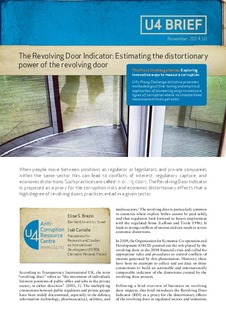| dc.contributor.author | Brezis, Elise S. | |
| dc.contributor.author | Cariolle, Joël | |
| dc.date.accessioned | 2018-01-04T08:19:21Z | |
| dc.date.available | 2018-01-04T08:19:21Z | |
| dc.date.issued | 2014-12-10 | |
| dc.identifier | oai:www.cmi.no:5310 | |
| dc.identifier.citation | Bergen: Chr. Michelsen Institute (U4 Brief 2014:10) 6 p. | |
| dc.identifier.uri | http://hdl.handle.net/11250/2474981 | |
| dc.description.abstract | When people move between positions as regulator or legislators and private companies within the same sector this can lead to conflicts of interest, regulatory capture, and economic distortions. Such practices are called revolving doors. The Revolving Door Indicator is proposed as a proxy for the corruption risks and economic distortionary effects that a high degree of revolving doors practices entail in a given sector.
This publication is part of a series on The Proxy Challenge – towards solving the anti-corruption measurement problem | |
| dc.language.iso | eng | |
| dc.publisher | Chr. Michelsen Institute | |
| dc.relation | U4 Brief | |
| dc.relation | 2014:10 | |
| dc.relation.ispartof | U4 Brief | |
| dc.relation.ispartofseries | U4 Brief 2014:10 | |
| dc.relation.uri | https://www.cmi.no/publications/5310-the-revolving-door-indicator | |
| dc.subject | Evaluation Measurement | |
| dc.title | The revolving door Indicator: Estimating the distortionary power of the revolving door | |
| dc.type | Report | |
